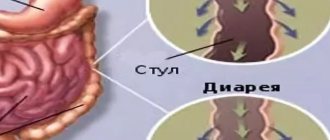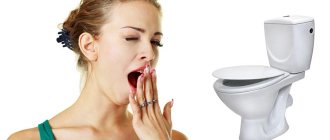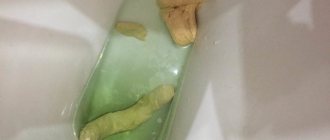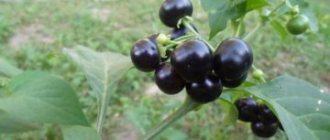Causes of diarrhea, what can cause diarrhea?
The following factors can contribute to the appearance of loose stools:
1 Infection with viruses or bacteria can cause diarrhea;
2 Eating spoiled food that contains pathogenic bacterial flora;
3 The presence of a large number of stressful situations in life;
4 Significant overeating can cause diarrhea;
5 Certain form of allergy;
6 Chronic diseases sometimes cause symptoms such as diarrhea;
7 Parasites in the body, in particular worms;
8 Individual intolerance to certain foods, or more precisely, their enzymes;
9 Insufficiently washed food products of plant origin;
10 Drinking water of poor quality can cause frequent loose stools;
11 Poor nutrition, when the body lacks certain elements;
12 Long-term use of antibiotics or other drugs that suppress microflora;
13 Various diseases of the gastrointestinal tract, such as gastritis, colitis and others;
14 Poisoning with a large number of toxins, for example, poisonous mushrooms or chemicals;
15 Eating large amounts of fiber, for example, with vegetables and fruits, which in itself enhances the contractile function of the digestive system.
The main types of diarrhea, what kind of diarrhea can it be?
Each of the above causes of diarrhea causes one of the following types of diarrhea:
1 Exudative, occurring in diseases of the gastrointestinal tract;
2 Medication, typical when using drugs that disrupt the normal intestinal microflora;
3 Alimentary, which occurs when an allergy or malnutrition factor is present;
4 Infectious, appearing along with infection of the body by certain viruses;
6 Toxic, caused by the consumption of poisons and chemicals;
7 Dyspeptic, when there is enzyme deficiency.
It should be noted that the causes of diarrhea are determined by certain characteristics that are different for each type, by which one or another type of diarrhea can be identified. Thus, the consistency, smell, color, presence of impurities and others can be different.
Brown diarrhea, why brown diarrhea appears, reasons
Brown color in shades from standard to dark brown is considered normal for humans, but this applies to stool with an exceptionally dense stool consistency. As mentioned earlier, the shade or color of feces depends on the food consumed, so the presence of dense brown feces indicates the normal course of all digestive processes. The appearance of liquid brown or brown stool may indicate infection with bacteria or parasites in the form of worms. More precisely, diarrhea does not occur from the presence of these bacteria and parasites, but from the products of their vital activity.
It should be noted that the presence of dark brown stool indicates the predominant consumption of meat and its derivatives. The stool becomes light brown when eating a large amount of food of the vegetable or dairy categories. It is considered the most dangerous if an almost beige color of the stool has become noticeable, which indicates critical disturbances in the functioning of the liver.
Gray color diarrhea, causes of gray color diarrhea
If an adult begins to suffer from diarrhea, in which the stool takes on a gray tint, then it is necessary to sound the alarm immediately, as this may indicate dangerous liver diseases, in particular hepatitis and even cirrhosis. Also, the gray color of stool during diarrhea can signal pathologies of the bile ducts, their blockage, which can lead to a cessation of the supply of bile to the intestines. The following deviations may be prerequisites for the development of this type of event:
1 Problems with the gallbladder, in particular cholecystitis;
2 Presence of stones or cancer in the gallbladder, bile ducts or liver;
3 Various inflammatory phenomena similar to pancreatitis;
4 Crohn's disease.
In addition to the above, gray stool during diarrhea can be caused by eating large amounts of very fatty foods. Also, internal antimicrobial and antifungal drugs can affect the gray coloration of feces.
Red diarrhea, why red diarrhea may appear
The predominance of red color in liquid and even dense feces during diarrhea is the most dangerous phenomenon, since in this case it may indicate the presence of hidden internal bleeding, requiring immediate medical intervention. Most often this is a consequence of the destructive effects of the development of malignant tumors in the digestive organs. This can also be caused by a variety of acute inflammatory processes that disrupt the integrity of the mucous membranes. It should be noted that the intensity of the shade can determine the approximate source of bleeding or inflammation. Thus, the dark red, almost black color of the diarrhea indicates that there is damage to the right half of the colon, and if the stool is bright red, one can judge that there is damage to the lower region of the intestine. A weak red color can usually appear with hemorrhoids or anal fissures.
However, you should not sound the alarm prematurely, since the first thing you need to do is remember what you ate in the last 24 hours. If your diet included tomatoes, beets or calcium-containing preparations, you can calm down until your next trip to the toilet.
Light diarrhea with cholecystitis
Cholecystitis, or inflammation of the gallbladder, often develops as a complication of gallstone disease. It is associated with damage to the inner surface of the organ wall and the entry of pathogenic bacteria into its lumen.
The appearance of white diarrhea in this case is accompanied by the following symptoms:
- Sharp pain in the right half of the abdomen.
- Temperature increase.
- Darkening of urine.
- The appearance of nausea or vomiting.
- Yellowing of the skin and mucous membranes.
- Increased gas formation.
Acute cholecystitis is an emergency condition. Patients with this diagnosis are treated in a hospital. Quite often, surgery is indicated to remove the gallbladder.
Green diarrhea, why do frequent loose green stools appear?
The green color of stool during diarrhea is characteristic of intestinal infections, which lead to an imbalance of the beneficial microflora of the digestive system relative to the harmful one. It should be noted that pathogenic microflora is constantly present in the body, but it is always suppressed by beneficial bacteria.
Green stools, green diarrhea, usually have a sour smell of rot and inclusions of mucus. A dangerous component of the causes of green diarrhea includes poor personal hygiene, previous treatment with antibiotic drugs, consumption of unwashed vegetables and fruits, problems with the liver, blood composition, and consumption of partially spoiled food. In the normal state of the body, the green color of feces can be acquired if a significant amount of greenery was eaten the day before, that is, spinach, lettuce, sorrel and others.
What treatment do doctors prescribe?
If the stool is pale yellow, a strict diet is first introduced for 3-5 days (at the discretion of the doctor). The following foods must be excluded from the diet:
- fatty meat (beef, pork);
- raw vegetables and fruits (boiled and baked - allowed);
- hot, spicy;
- fatty fermented milk products;
- onions, garlic, ginger (even in the form of a tea decoction);
- alcohol, carbonated drinks.
If the doctor prescribes a “fasting day,” this means that you can only drink water and eat only well-cooked rice (in small portions every 2-3 hours).
Also, when prescribing a diet, all food is consumed exclusively in puree form. Even porridge should be ground using a blender or food processor. You should also temporarily stop taking medications that stimulate fluid absorption in the intestines. You should definitely tell your doctor about all medications you take.
Black diarrhea, causes of black diarrhea
Black color or shade of loose stool is a sign of serious damage to the walls of the gastrointestinal tract with prolonged bleeding. The color of diarrhea turns black because before leaving the body through diarrhea, the blood has time to bake and become almost black. Also, the black color of stool during diarrhea predominates when there is significant damage to the upper areas of the intestine, while the consistency of the stool turns into tar-like with an incredibly foul odor. Very often, such diarrhea is accompanied by black vomit, which poses a huge threat to a person’s life, since this means that very significant blood loss is currently occurring, even leading to coma. However, there is also a safe side to black diarrhea, which is associated with the usual use of activated carbon, alcohol, bismuth-based medications and others.
White or pale color with diarrhea, causes
Typically, the white color with diarrhea appears due to the presence of bile insufficiency, which can be caused by the above-mentioned pathologies of the gallbladder, bile ducts and liver. Also, the pale color of diarrhea is influenced by the presence of malignant tumors of any of the organs involved in digestion. In this case, it is necessary to carefully monitor the regularity of diarrhea, since in cases of cancer, diarrhea becomes constant and almost chronic. In other cases, the symptoms of diarrhea with white or pale stools are short-term, in most cases one-time. This can be caused by poor diet, consumption of large amounts of rice, dairy products or alcohol abuse.
What you can eat and what is not recommended
If light-colored stools occur due to the same type of diet, abuse of light-colored and fatty foods, you need to add variety to your daily diet. Experts advise eating cereals made from cereals such as pearl barley, buckwheat or lentils for breakfast.
After a hearty lunch and dinner, it is recommended to drink a glass of fresh juice; you can eat an apple, banana or grapefruit, which will help you cope with the process of fat breakdown more easily.
If white feces appear after eating plant foods, doctors say there is nothing to worry about. This is a physiological process of self-cleansing of the body, which takes place on its own.
Orange diarrhea, causes of orange diarrhea
In many ways, the color of stool during diarrhea depends on what the person ate the day before. The orange color of diarrhea begins to predominate in the stool after eating foods containing large amounts of vitamin A. This vitamin is most found in plant foods that are orange, red or yellow in color. This could be pumpkin, carrots, cauliflower, apricot, melon, nectarine, plum and many others. It should be noted that an overdose of vitamin A in the body is fraught with nausea, vomiting, intestinal colic, and itching. The next reason for the appearance of orange stool during diarrhea may be taking medications that stop some gastrointestinal processes.
In addition to all of the above, the following body pathologies can be the causes of orange loose stools:
1 The presence of any inflammatory processes in the digestive system;
3 Hormonal imbalances;
4 Diseases related to bile drainage pathways;
5 Pulmonary diseases;
6 Cystitis in various forms;
8 It can often occur in women during menopause.
How is it formed and what does it consist of?
From the stomach, food masses enter the duodenum, where they are mixed with bile produced by the liver and digestive enzymes of the pancreas. During the digestion of proteins, fats and carbohydrates, a suspension is formed that moves through the small intestine. The small intestine absorbs nutrients into the blood, and the remaining liquid waste enters the large intestine. In the large intestine, the remaining water is absorbed and feces are formed, which are excreted into the environment through the distal part of the digestive tract - the rectum.
Normal stool consists of water, remains of animal food, undigested plant fibers, bacteria (up to 1/3 of the dry weight of stool), bile, and dead cells of the mucous membrane lining the digestive tract. The composition, consistency, quantity and color of feces depend on many factors and are one of the indicators of the health of the body in general and the gastrointestinal tract in particular.
Diet
A color change in stool is a direct reason to reconsider your diet. Patients should reduce or completely eliminate fatty foods, everything fried, salty, spicy or pickled. Mushrooms and a lot of chocolate are strictly contraindicated.
Special herbal mixtures, tinctures, herbal tea from sage, chamomile or drinks from sprouted oats help normalize the functioning of the liver, bile ducts and stabilize intestinal function.
The main task of the diet is the gentle effect of foods on the body without loss of saturation. You need to eat in small quantities, the last meal should be 3 hours before bedtime. Products must be thoroughly crushed, preferably even ground. Food is cooked better by steaming.
At the first signs of the appearance of colorless feces, you need to seek help from specialists. Only they will help identify the exact reasons that caused these phenomena and select the ideal treatment plan to restore the functioning of the digestive system.
Normal stool color
Stools are usually brown in color, and significant changes in color may be a cause for health concern. The color of stool is determined by the presence of bilirubin (a breakdown product of hemoglobin) and other bile pigments. Changes in the amount of bilirubin in the bile can change the color of the stool from light yellow to dark brown.
In most cases, changes in the color of stool are associated with dietary habits and are not a symptom of any health abnormalities. However, in some cases, for example, if the color of the stool has changed radically, and these changes persist for a long time, this can be an important diagnostic sign of dangerous diseases and serious life-threatening conditions.
When should a change in color alert you?
A cause for concern should be those cases when a change in stool color is accompanied by other symptoms:
- Green and foul-smelling stools are accompanied by diarrhea, abdominal pain, high fever, nausea and vomiting - possible symptoms of some infectious diseases, such as salmonellosis.
- Discolored feces are accompanied by pain in the abdomen, back, yellowness of the sclera and skin, darkening of the urine - signs of problems with the liver and biliary tract.
- Stool staining black is accompanied by abdominal pain, weakness, pale skin, increased heart rate, cold sweat - symptoms of bleeding in the stomach or duodenum.
- Red stool is accompanied by abdominal pain, nausea and vomiting - these may be signs of intestinal bleeding.
First aid
What to do if a child has white diarrhea? It is best to immediately call a pediatrician at home so that he can check the general condition of the baby. Of course, a one-time problem with bowel movements should not be a reason to sound the alarm, but a recurring one should be.
Please note the following symptoms, the presence of which should be reported to your doctor immediately:
- painful sensations (if the child does not speak yet, you can simply touch the tummy, he will let you know about the pain by crying and trying to change position);
- nausea, vomiting;
- loss of appetite;
- moodiness, sleep disturbance, loss of strength;
- increased body temperature;
- coating on the tongue, bad breath;
- other suspicious symptoms.
It is better not to give any medications until the doctor arrives. You also need to limit your food intake, it’s better to just not eat anything; in the case of infants, you shouldn’t stop feeding. Before the doctor arrives, it is recommended to give the child warm water and chamomile tea.
If there is a need to give a child a drug to alleviate the condition, you can use Smecta
Green stool is a sign of what?
As already mentioned, the brown color of stool is due to the presence of bilirubin in it. Bilirubin enters the lumen of the duodenum with bile, the color of which, depending on the concentration of this substance, can vary from greenish-yellow to dark brown. As it passes through the intestines, the chemical composition of bile changes and it darkens. If the movement of feces through the intestinal lumen becomes too fast, the bile retains its original color and the stool becomes green. This can happen with diarrhea caused by food poisoning, salmonellosis, rotavirus infection, giardiasis, Crohn's disease, autoimmune and endocrine diseases.
Green stool may occur if you eat a lot of green vegetables.
Green feces in an adult may be due to intestinal dysbiosis. In this case, a detailed scatological examination for dysbiosis will help establish the diagnosis.
Green stools, accompanied by cutting pain in the abdomen, diarrhea, and an admixture of mucus and pus in the stool are signs of acute infectious enterocolitis. Treatment in this case is prescribed by an infectious disease doctor based on the results of a bacteriological examination of stool and establishing the sensitivity of pathogenic microflora to a particular group of antibacterial drugs. In addition to antibacterial treatment, enterocolitis requires replenishment of fluid losses, including parenteral administration of electrolyte solutions.
Green stool may also have a completely normal explanation that is not related to illness, for example, after eating a large amount of green leafy vegetables (especially spinach), foods with appropriate food colorings, or some dietary supplements. Sometimes a change in color is provoked by taking iron supplements, but most often the stool in this case does not turn green, but turns black.
Green stool in children can be caused by the same diseases as in adults. In newborns in the first days of life, green stool is a normal variant called meconium.
Reasons for appearance
In a healthy person, the color of feces ranges from brown to dark yellow. The consistency is quite dense, but not hard, the feces are formed. The physiological norm varies quite widely, so if the feces have acquired a viscous consistency, this is not a reason for concern.
The shape, smell and density of feces are affected by diet and the amount of water in the small intestine. The first factor, as a rule, provides temporary changes that do not threaten health. Impaired absorption of water in the intestines is much more likely to indicate serious illness.
Brown chair
The causes of diarrhea are divided into dangerous and relatively harmless. Brown diarrhea occurs under the influence of the following factors:
- Most often, a change in color results from the consumption of coloring and laxative products: beets, blood sausage, black currants, tomato juice. Such diarrhea disappears on its own within two days.
- Too much water and salts in the intestines stimulate peristalsis. Accordingly, feces do not have time to form and turn into dark brown or yellow diarrhea in both children and adults.
- Switching to a strict diet sometimes provokes the appearance of brown stool. Thus, the body reacts to changes in nutrition. As soon as a person adapts to the restriction, the diarrhea goes away.
- Some medications turn stool brown or black and cause bowel problems. Thus, taking activated carbon gives feces an unnaturally dark brown color. Medicines containing bismuth or iron and used in the treatment of the gastrointestinal tract also cause brown diarrhea.
- Inflammations, such as colitis, often cause dark brown or black diarrhea. With this disease, the functioning of the gastrointestinal tract is disrupted, and the body tries to remove undigested food as quickly as possible.
- If the stool turns light brown and becomes semi-liquid, it is necessary to check the functioning of the pancreas. This color is characteristic of feces with insufficient bile secretion. The same changes are observed in liver pathology.
Important! With uncontrolled use of products containing acetylsalicylic acid, more serious consequences are possible. The drug itself does not cause any disorder, but may cause internal bleeding. Blood in feces turns it dark brown.
A change in the color of a child's stool to brown and the appearance of diarrhea is often associated with the transition to a new diet. In such cases, the disorder goes away on its own and is not accompanied by additional symptoms. If, due to stool disorder, the temperature rises and vomiting is observed, then diarrhea is most likely associated with an intestinal infection.
Red chair
Red diarrhea or stool containing streaks of blood is a sign of a dangerous disease, as it appears due to internal bleeding. The intensity of the color indicates the nature of the disease:
- Dark red diarrhea is a symptom of damage to the upper digestive tract: stomach, esophagus, small intestine. Observed in ulcerative colitis or Crohn's disease.
- A less intense color is observed in diarrhea due to hemorrhoids and anal fissures.
- Bright red blood in the stool occurs when there is bleeding in the small or large intestine. The most common cause is intestinal infections.
- In an adult, dark red or purple diarrhea occurs when the right side of the large intestine is damaged.
Dark or red diarrhea in a child appears for the same reasons as in an adult. But since the baby’s immune system is less developed, the disease develops much faster. If you have these symptoms, you should call an ambulance.
What does black stool mean?
Feces can turn black in a completely healthy person in the following cases:
- When eating blueberries, prunes, pomegranates, black currants, bird cherry, red wine, red beets.
- After eating dishes and products based on or containing blood, for example, rare meat, blood sausage, etc.
- While taking iron supplements for the treatment of iron deficiency anemia, bismuth supplements, multivitamins, activated carbon.
In these cases, the help of doctors is not required, and the color of the stool returns to normal within a few days after changing the menu and stopping treatment.
Black stool is a symptom of dangerous bleeding in the upper gastrointestinal tract
The sudden and inexplicable appearance of black stool (melena) is one of the serious symptoms of internal bleeding into the cavity of the stomach or duodenum. The black color is due to the interaction of hemoglobin in the blood with hydrochloric acid in the gastric juice, resulting in the formation of black hemin. Bleeding can be caused by a peptic ulcer, tumor, injury, bleeding disorder, varicose veins of the esophagus due to liver disease, infectious process and other reasons.
General recommendations
Treatment of white diarrhea is carried out depending on the cause that caused the unpleasant symptom. For therapy to be effective, it is important to conduct an appropriate examination. Only a doctor can interpret the results and select medications.
Intestinal disorder, manifested by white diarrhea, is usually treated in a hospital setting, as it is caused by serious pathologies. Regardless of the reasons for the diarrhea, there are recommendations to help alleviate the patient's condition.
- Replenishing water balance.
- Delicate massage.
To prevent a person suffering from diarrhea from becoming dehydrated, it is important to give them plenty to drink. You should be especially careful when white diarrhea develops in a child. When it comes to treating infants, the frequency of feedings should never be reduced. This can lead to serious consequences.
Any liquid is suitable for replenishing water balance. You cannot drink soda, sugary drinks, sweet tea and coffee. You can add a slice of lemon to water or mineral water. This is true if there are no intestinal or stomach ulcers.
A gentle massage of the abdominal area will help relieve antispasmodic pain. You can perform clockwise circular movements for several minutes.
Red stool – is it a reason to worry?
Red stool appears when there is bleeding into the intestinal cavity.
There is no reason to worry if the day before you ate beetroot dishes or consumed drinks and confectionery products colored with red food coloring.
Among pathological conditions, the most common cause of red stool is bleeding from hemorrhoids. More dangerous causes of bleeding into the intestinal cavity and redness of the stool are Crohn's disease, ulcerative colitis, intestinal diverticulosis, malignant tumors, and arteriovenous malformations.
Severe bleeding in the upper gastrointestinal tract can also cause red stool. In this case, hemoglobin does not have time to react with hydrochloric acid, so the blood in the stool does not turn black, but remains red.
Reasons for appearance
In a healthy person, the color of feces ranges from brown to dark yellow. The consistency is quite dense, but not hard, the feces are formed. The physiological norm varies quite widely, so if the feces have acquired a viscous consistency, this is not a reason for concern.
The shape, smell and density of feces are affected by diet and the amount of water in the small intestine. The first factor, as a rule, provides temporary changes that do not threaten health. Impaired absorption of water in the intestines is much more likely to indicate serious illness.
Brown chair
The causes of diarrhea are divided into dangerous and relatively harmless. Brown diarrhea occurs under the influence of the following factors:
- Most often, a change in color results from the consumption of coloring and laxative products: beets, blood sausage, black currants, tomato juice. Such diarrhea disappears on its own within two days.
- Too much water and salts in the intestines stimulate peristalsis. Accordingly, feces do not have time to form and turn into dark brown or yellow diarrhea in both children and adults.
- Switching to a strict diet sometimes provokes the appearance of brown stool. Thus, the body reacts to changes in nutrition. As soon as a person adapts to the restriction, the diarrhea goes away.
- Some medications turn stool brown or black and cause bowel problems. Thus, taking activated carbon gives feces an unnaturally dark brown color. Medicines containing bismuth or iron and used in the treatment of the gastrointestinal tract also cause brown diarrhea.
- Inflammations, such as colitis, often cause dark brown or black diarrhea. With this disease, the functioning of the gastrointestinal tract is disrupted, and the body tries to remove undigested food as quickly as possible.
- If the stool turns light brown and becomes semi-liquid, it is necessary to check the functioning of the pancreas. This color is characteristic of feces with insufficient bile secretion. The same changes are observed in liver pathology.
Important! With uncontrolled use of products containing acetylsalicylic acid, more serious consequences are possible. The drug itself does not cause any disorder, but may cause internal bleeding. Blood in feces turns it dark brown.
A change in the color of a child's stool to brown and the appearance of diarrhea is often associated with the transition to a new diet. In such cases, the disorder goes away on its own and is not accompanied by additional symptoms. If, due to stool disorder, the temperature rises and vomiting is observed, then diarrhea is most likely associated with an intestinal infection.
Red chair
Red diarrhea or stool containing streaks of blood is a sign of a dangerous disease, as it appears due to internal bleeding. The intensity of the color indicates the nature of the disease:
- Dark red diarrhea is a symptom of damage to the upper digestive tract: stomach, esophagus, small intestine. Observed in ulcerative colitis or Crohn's disease.
- A less intense color is observed in diarrhea due to hemorrhoids and anal fissures.
- Bright red blood in the stool occurs when there is bleeding in the small or large intestine. The most common cause is intestinal infections.
- In an adult, dark red or purple diarrhea occurs when the right side of the large intestine is damaged.
Dark or red diarrhea in a child appears for the same reasons as in an adult. But since the baby’s immune system is less developed, the disease develops much faster. If you have these symptoms, you should call an ambulance.
Is it dangerous when stool is white?
White feces are one of the characteristic symptoms of liver and biliary tract diseases. Discoloration of the stool is explained by the lack of bilirubin in it, which ceases to be supplied with bile as a result of impaired liver function or obstruction of the bile ducts. But there is a lot of it in the blood, and this can be seen with the naked eye, since it turns the skin and eyes yellow - this condition is called jaundice. In addition, bilirubin begins to be excreted intensively by the kidneys, as a result the urine becomes dark, as doctors say, the color of beer. Undoubtedly, this is a dangerous condition that requires immediate specialist intervention and proper treatment.
Yellow or white stool is a sign of liver and pancreas disease
Light and loose stools with an unpleasant odor are a sign of impaired pancreatic function. The deficiency or absence of a number of enzymes makes it impossible to digest fats, resulting in light-colored stools. Lightening of the stool after eating a fatty meal may indicate chronic pancreatitis, celiac disease, cystic fibrosis, pancreatic cancer, gallbladder cancer, compression of the biliary tract or blockage due to cholelithiasis. The consequences of these diseases can be very serious, so you should not delay visiting a doctor.
White feces can also appear normally, for example, with errors in nutrition, in particular, with the abuse of fatty foods: lard, butter, fatty sour cream, etc.
Another variant of the norm is stool discoloration while taking certain medications: antibiotics, antifungals, gout medications, anti-inflammatory drugs, oral contraceptives. A few days after completing the course of treatment with such drugs, the color of the stool returns to normal. To avoid unnecessary worries, before taking medications, you should carefully read the instructions for the drug, especially the section on side effects and symptoms of overdose.
When to see a doctor
Unnatural white color and loose stools in a child are a compelling reason to consult a doctor. Even if it is just an eating disorder, it is important to rule out serious illnesses and get advice from a pediatrician regarding the child’s diet.
Dangerous signs of dehydration that require immediate emergency medical attention:
- diarrhea for more than 3 days;
- abdominal pain;
- constant thirst;
- incessant vomiting;
- absence of tears or urine for more than 3 hours;
- convulsions, lethargy;
- retraction of the fontanel in infants;
- decreased skin elasticity, sunken eyeball;
- increased breathing, shortness of breath, increased blood pressure;
- coldness of hands and feet;
- dry skin.
The child becomes restless, weakened and tearful, eats and sleeps poorly. Infants often burp, refuse to eat, and when there is severe pain, they pull their knees up to their stomach.
Children under 1 year of age with severe signs of diarrhea should always call an ambulance. At this age, irreversible dehydration can develop within a few hours, and professional rehydration or fluid replacement in the form of an IV is urgently needed.
With any prolonged diarrhea, children lose vital fluids and electrolytes, which can be fatal. If for some reason it is impossible to call doctors or the patient’s condition is very serious, you need to act independently.











